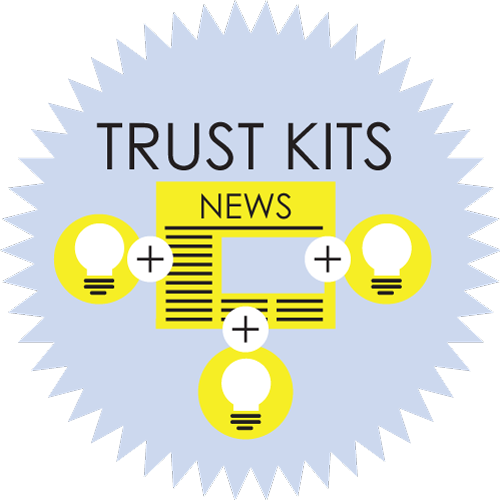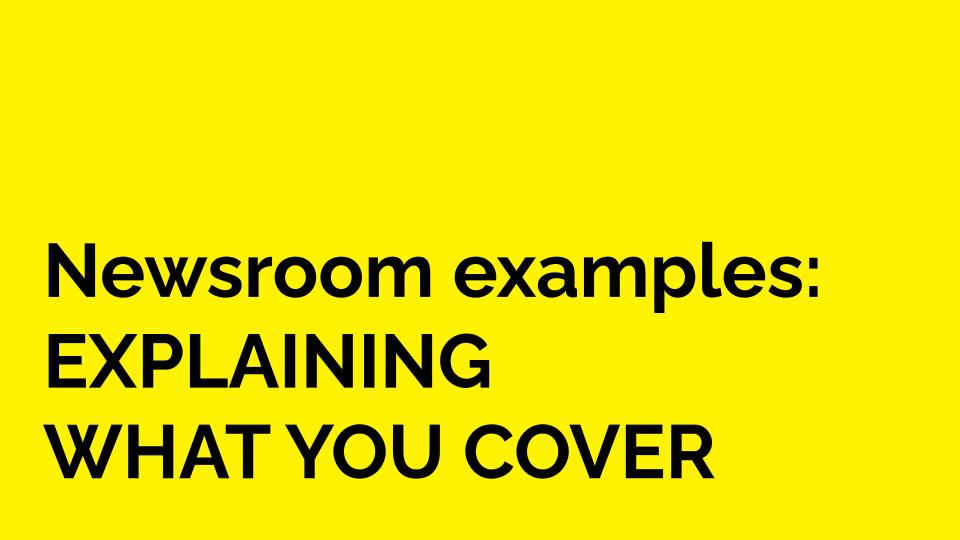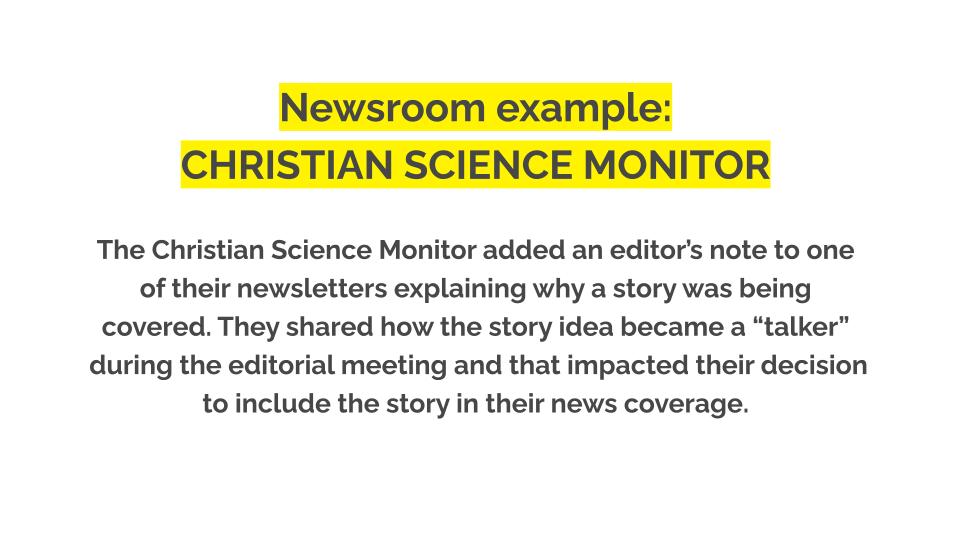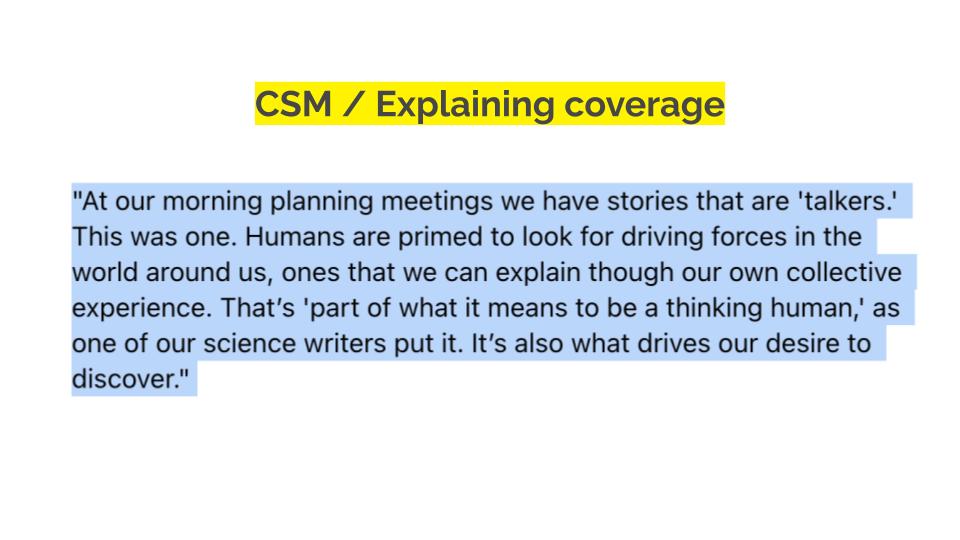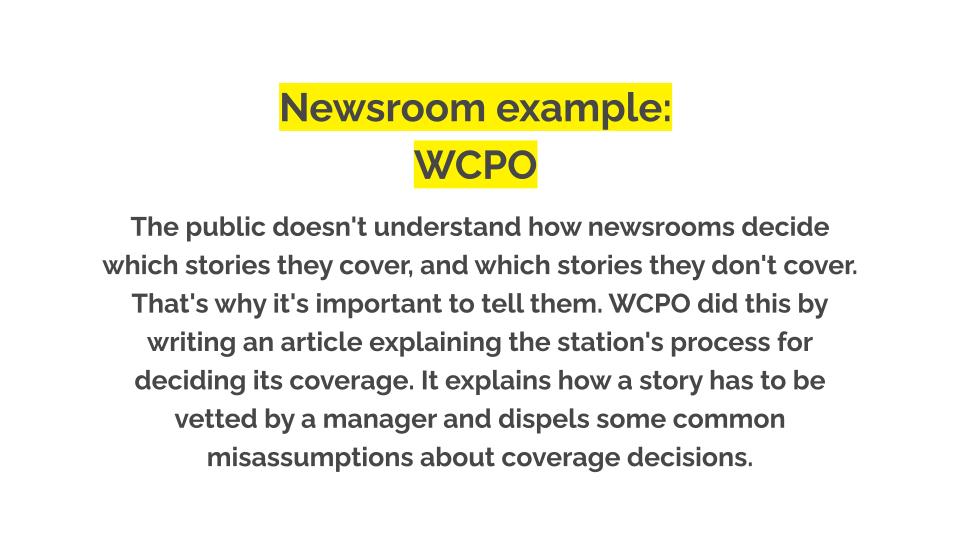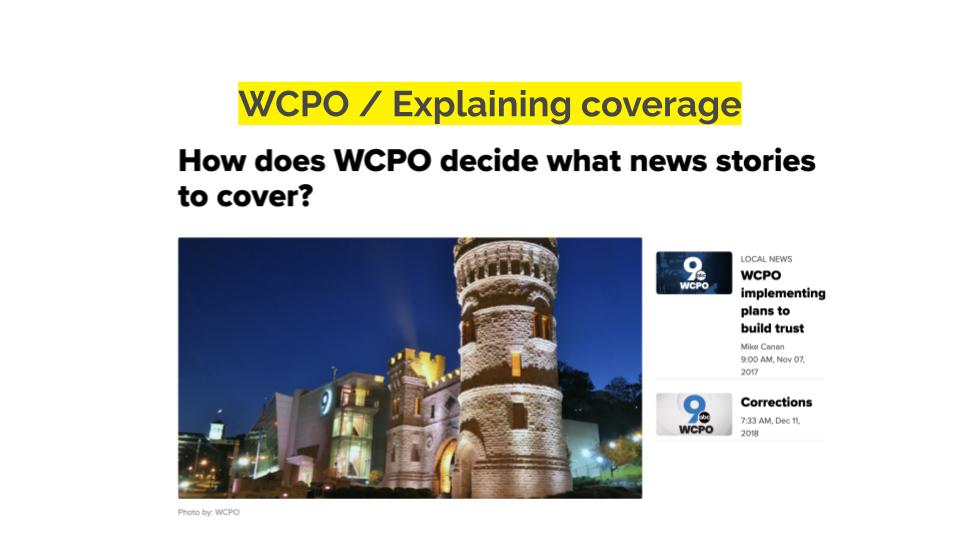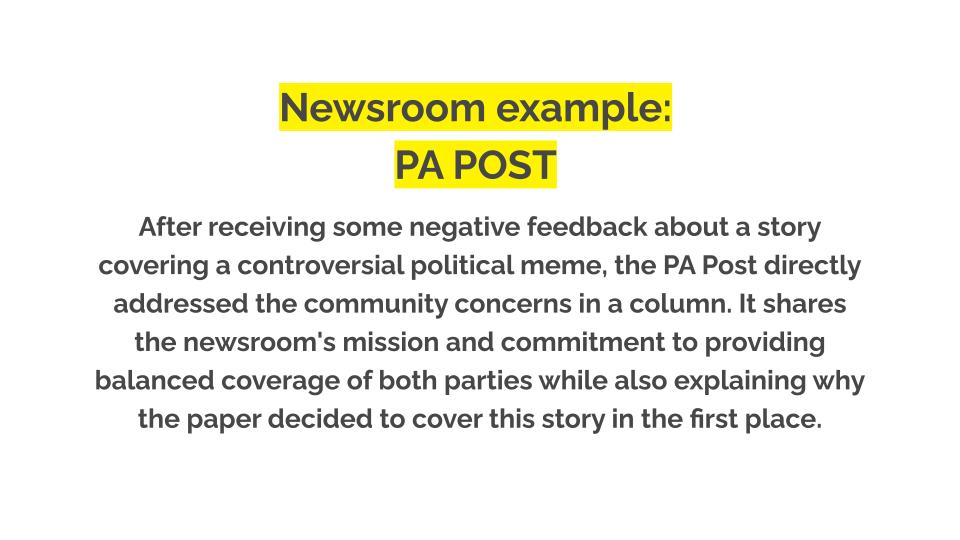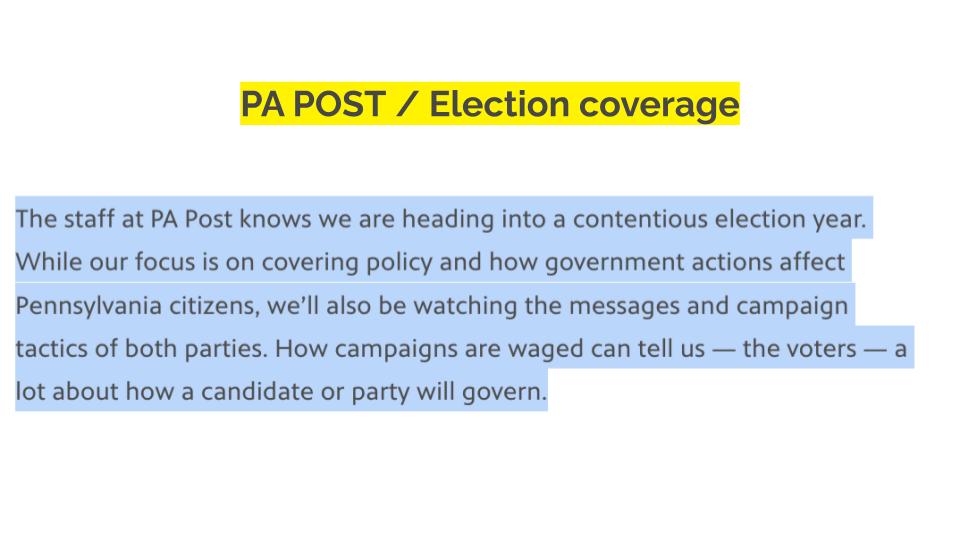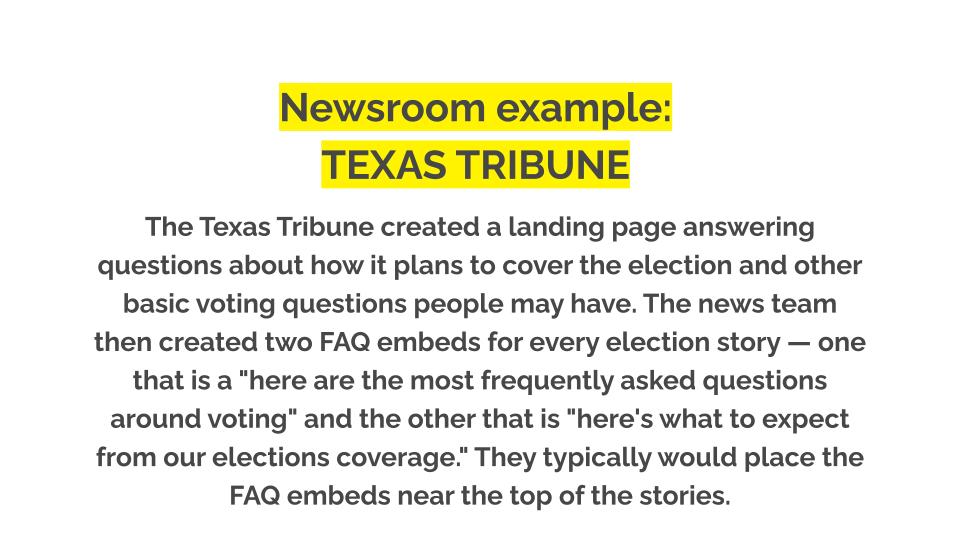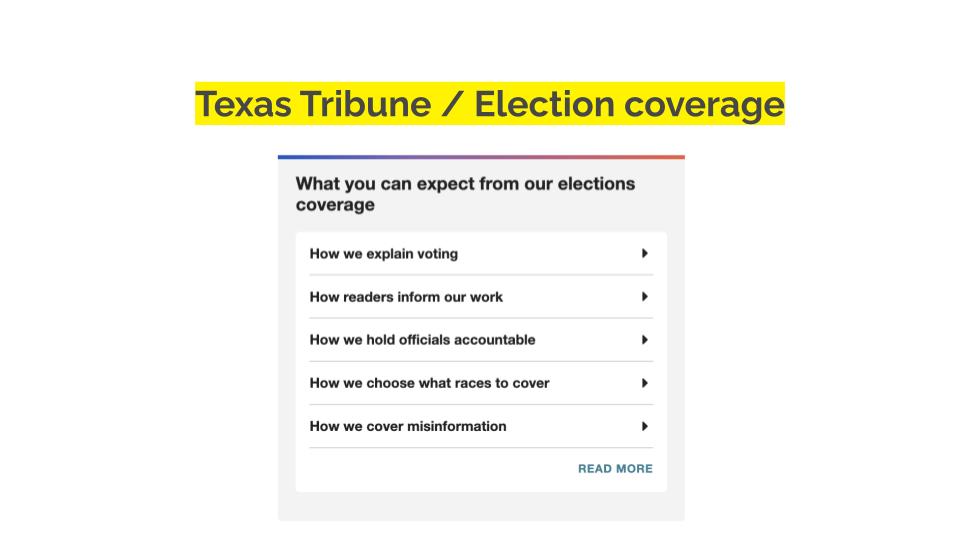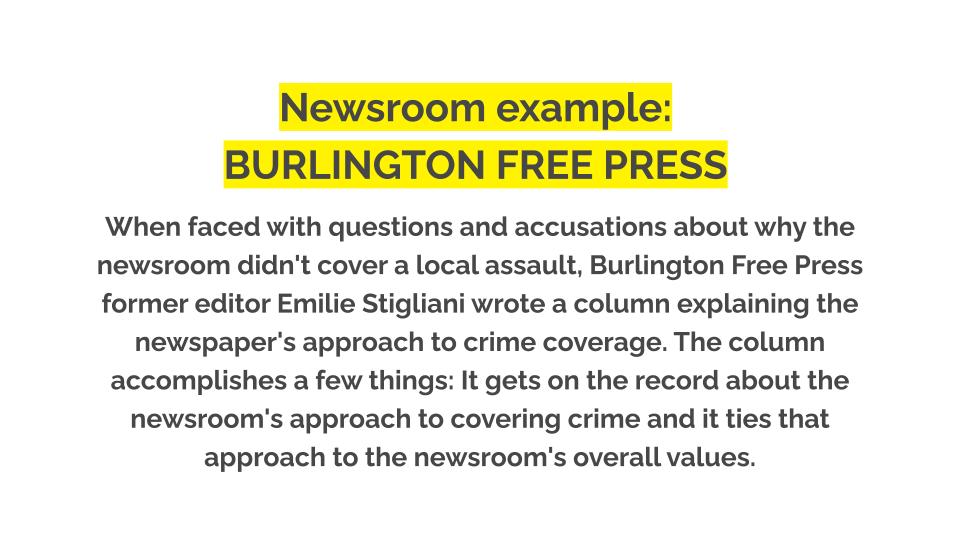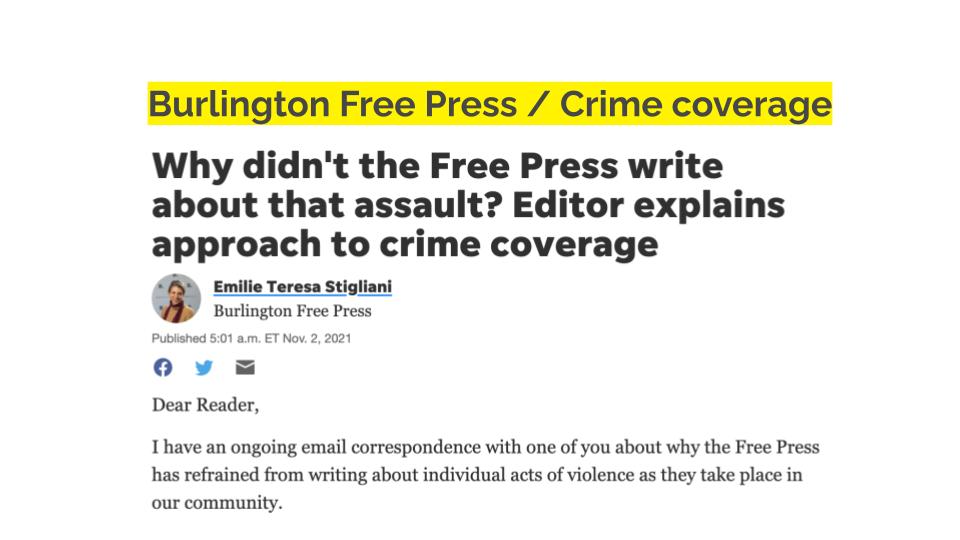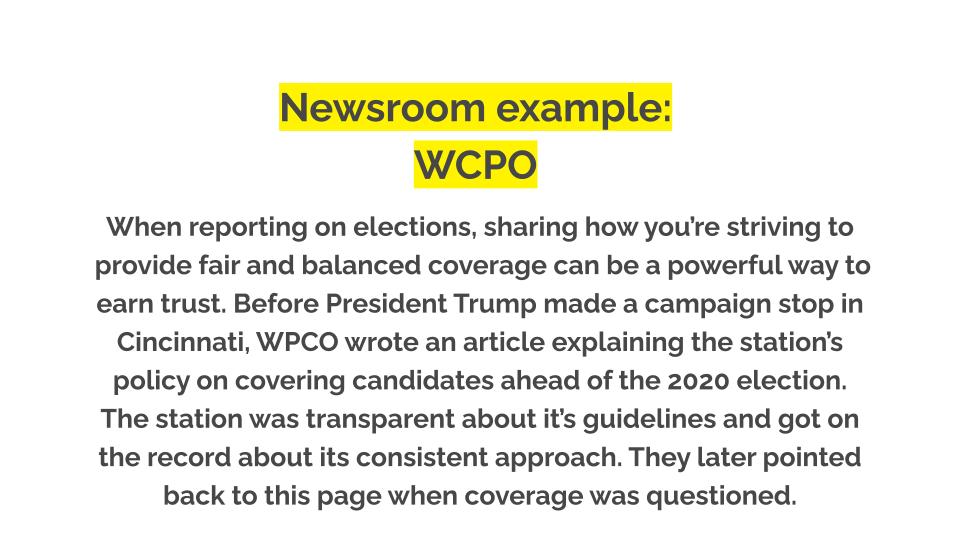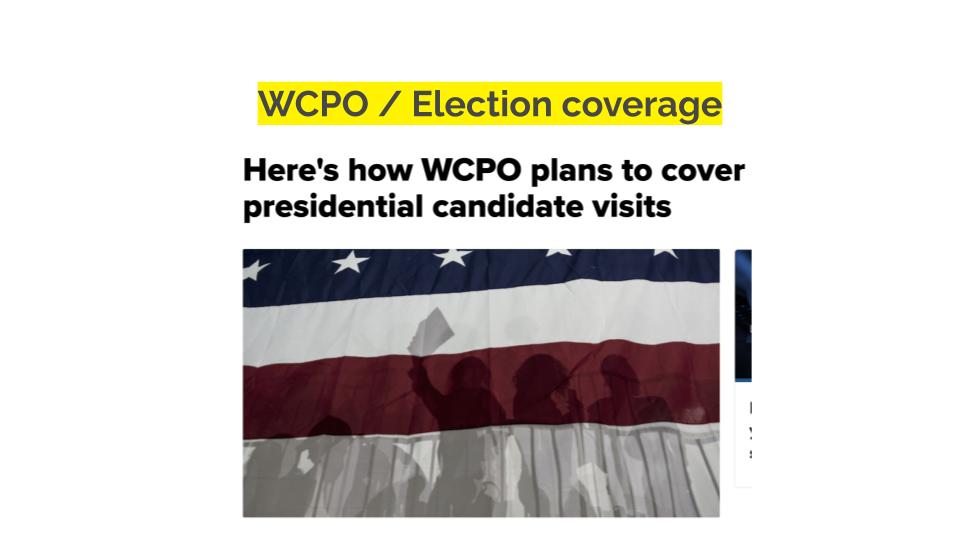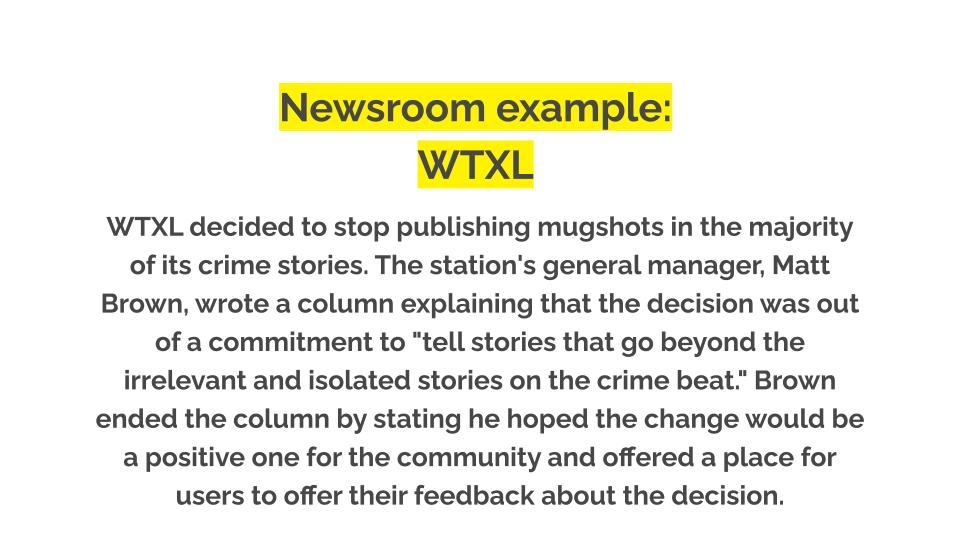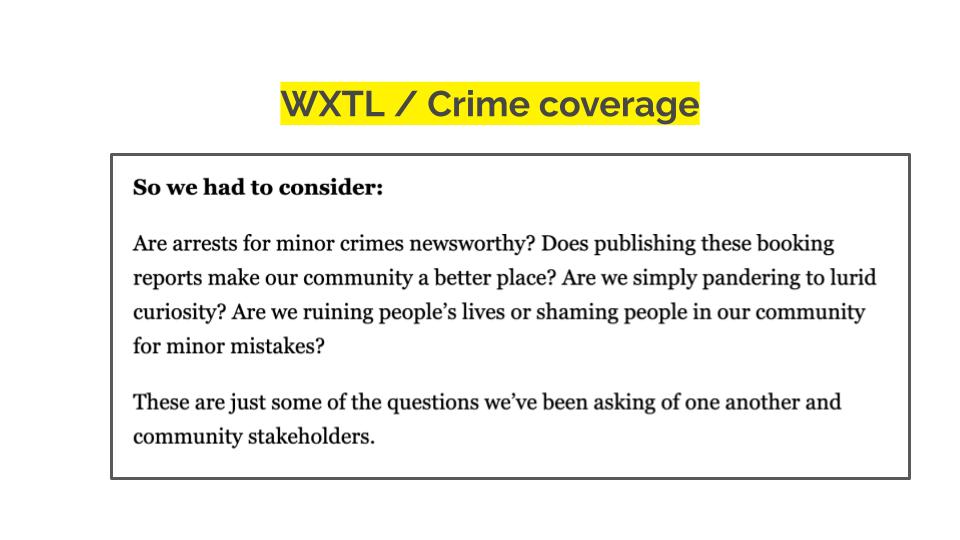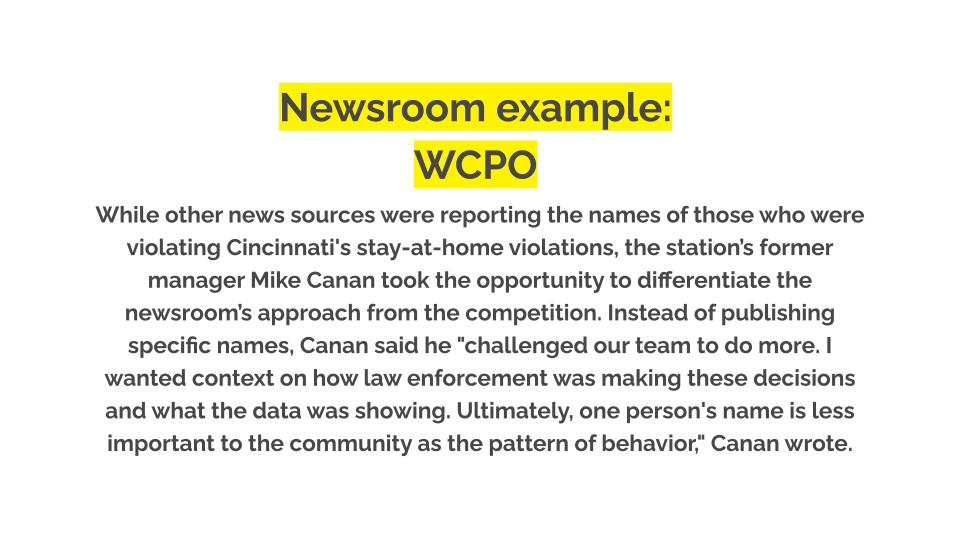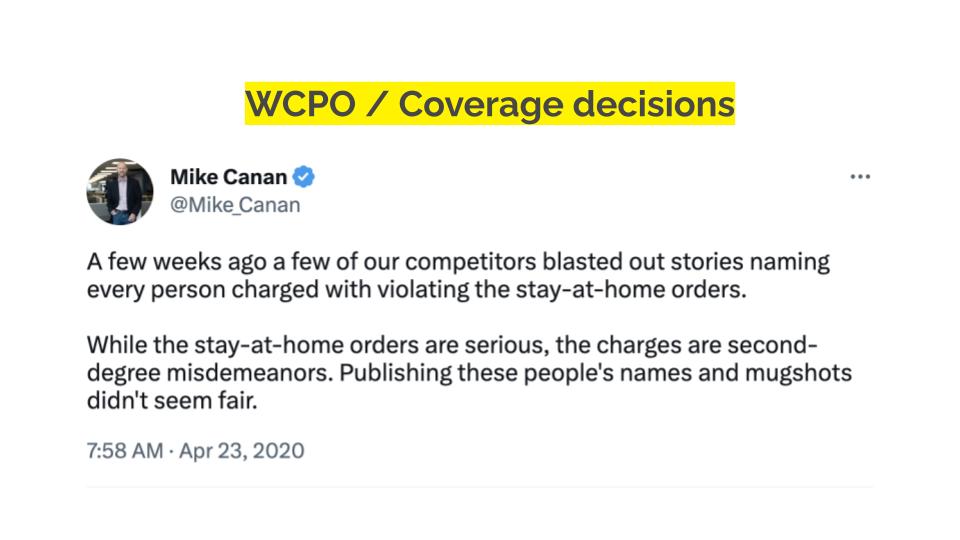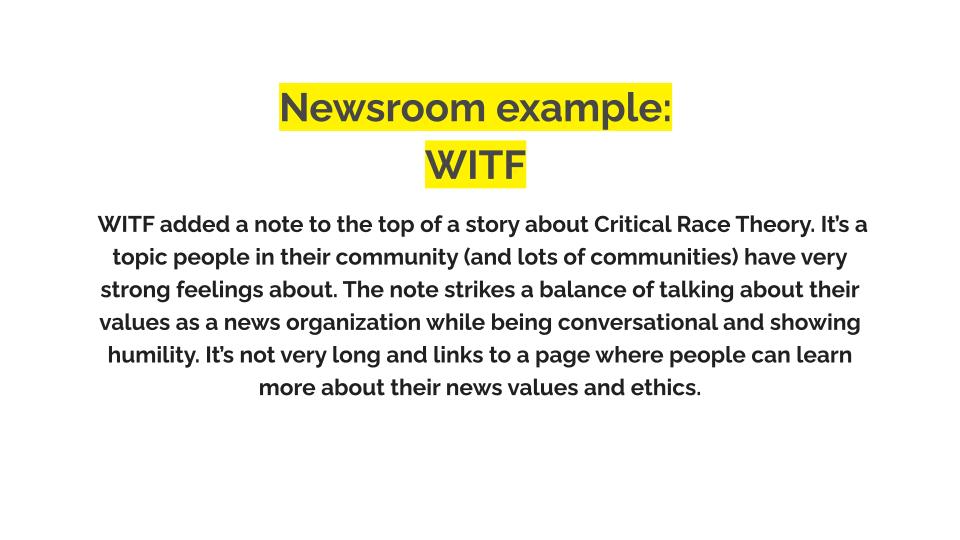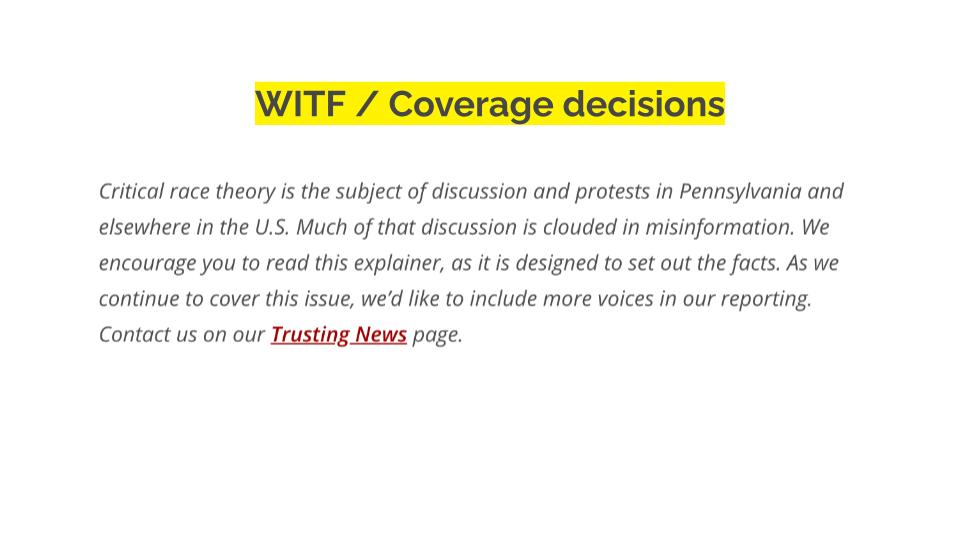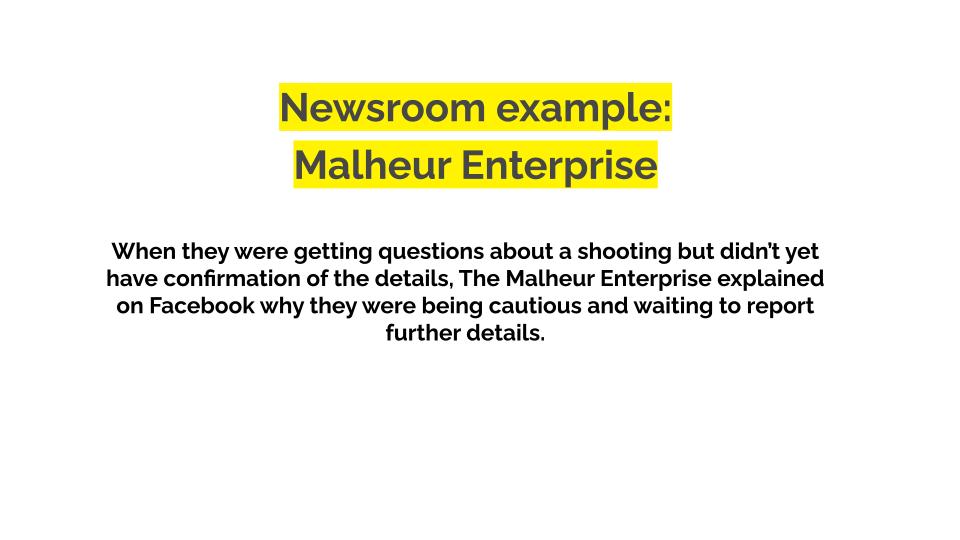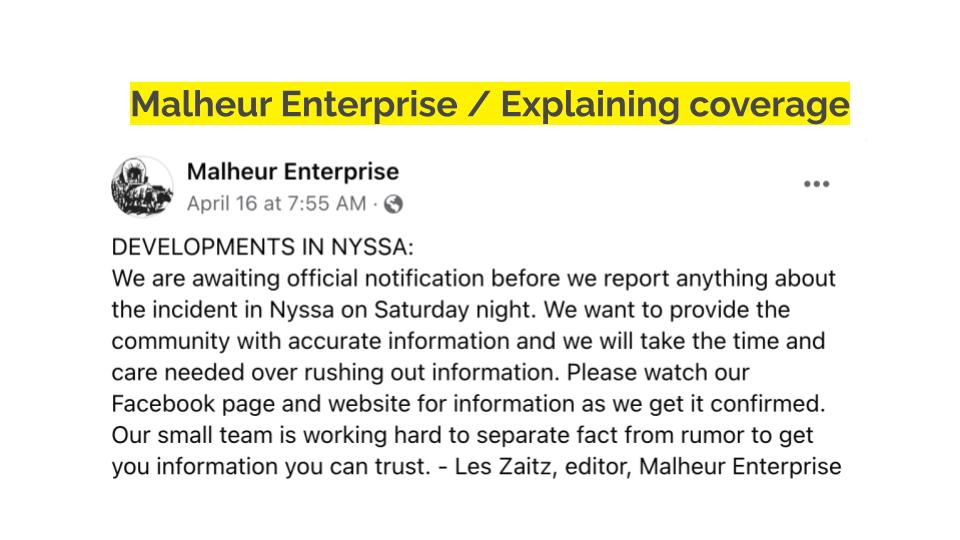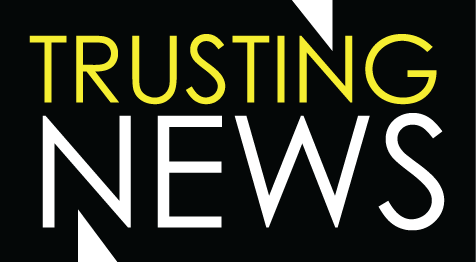ETHICS & FAIRNESS
EXPLAIN WHAT YOU COVER
Picture the process of how your newsroom decides which stories to cover. Which meetings? Which crimes? Which festivals? Which games?
If we’re honest, a lot of those decisions happen intuitively. We have conventions we follow about what’s newsworthy and what’s not. We have big-picture fairness we try to achieve when it comes to who and what gets attention. We keep track of what stories we did last year and try not to repeat them.
If we’re *really* honest, some of those decisions are based on conventions we don’t really verbalize, much less explain to the public.
Well, your audience notices what you cover and wonders about what you don’t cover. And if you don’t let them in on your process, they’ll make all kinds of assumptions about your motivations and decision-making. They may assume a reporter is friends with the business owner featured in a story, or the boss’ kid goes to the school highlighted in a story, or a politician paid you to cover a topic or event.
Instead of letting misassumptions damage people’s trust in you, let your users know what criteria you DO use when deciding coverage.
The public is paying attention to what stories journalists decide to tell. If you don’t explain your story selection process, people will make all sorts of assumptions about the motivation behind your coverage.

Goals
This Trust Kit helps you:
- Explain what drives your coverage decisions
- Get on the record about what impacts your ability to cover stories and why you choose not to cover some stories
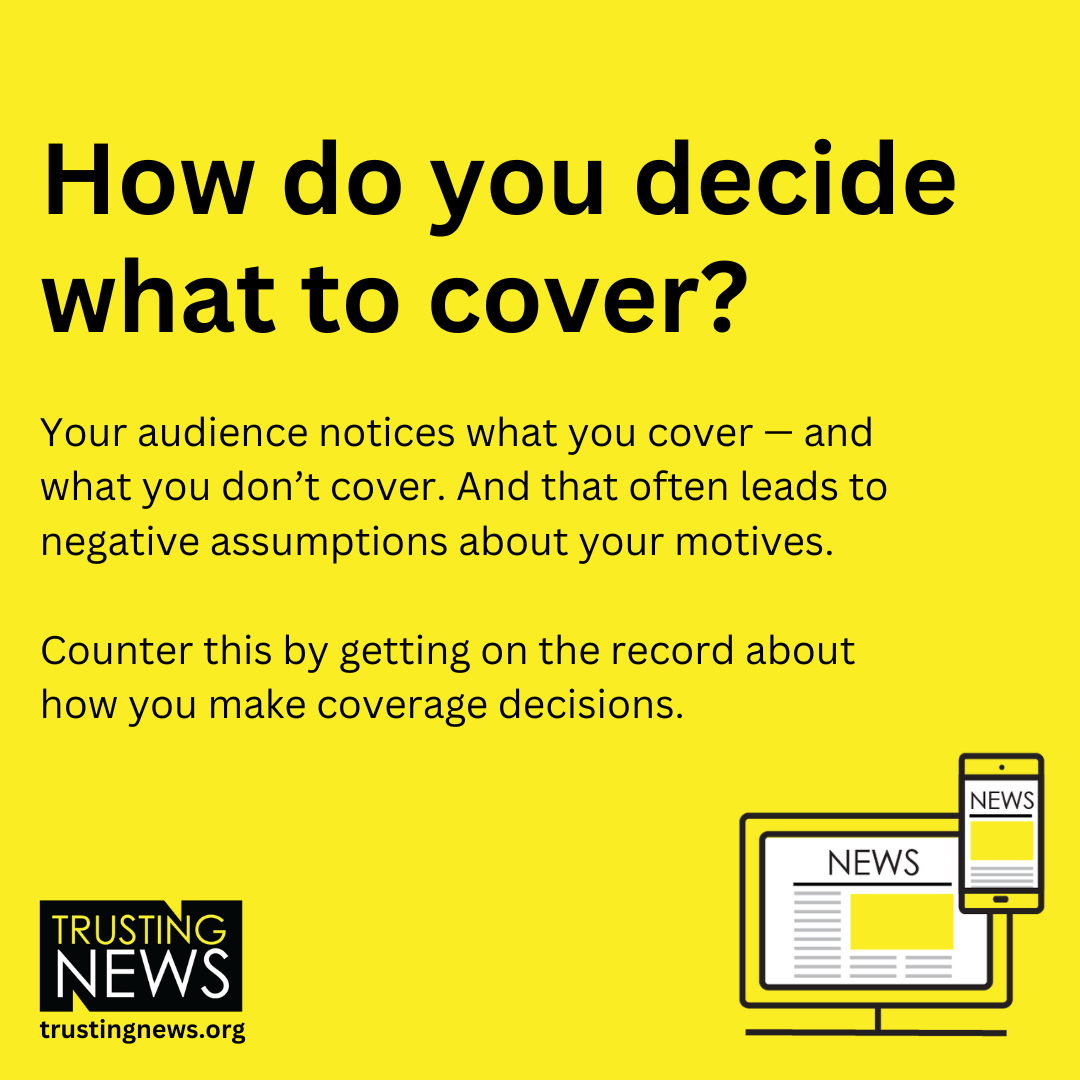

When to explain coverage decisions
It’s a good idea to explain the general idea of your approach to covering stories and which stories you choose to cover. But it also may be important to explain for individual stories why it is you’re choosing to cover them.
If you’re wondering how to do that, here are some situations when it’s especially good to get on the record about your story selection with your audience.
- When you cover something you don’t normally cover or if you’re covering something differently. Again, people take note when we veer from the norm. If you’re covering a topic you don’t normally cover, or you decided to cover something at a different volume than normal (like perhaps increased healthcare coverage during the pandemic, or increased political coverage during an election cycle) clue your audience into why that is.
- If a story raises a lot of questions or prompts discussions in the newsroom. Are people in the newsroom unsure if it should be covered, or split on how something should be covered? If a story is causing a lot of discussion, or disagreement, in the newsroom, it’s likely it will do the same in the community.
- If it’s a controversial or polarizing topic in the community or in national media. We know covering these types of stories can be tricky. You have to balance being accurate and factual with being fair. It’s almost guaranteed that someone or a group of people will disagree with your coverage or see the headline, make a judgment that the story is biased and skip it altogether. Explaining the why behind your coverage can help mitigate complaints and negative accusations.

How to explain your decisions
Want to start getting on the record your coverage decisions, but aren’t sure what to put in your explanation?
Below is a list of elements we recommend you include as you work to get on the record about your coverage decisions.
Once you’ve gotten on the record, insert those explanations in the places where your users are already consuming your news content. Some ideas could be: In a pull-out box alongside the story; in a note above the story; within on on-air story; in the story text itself; on a social post, or in a newsletter blurb.
Click or tap the blue boxes to expand each section.
Point to your mission and goals.
Whether working as an individual journalist or as a newsroom, share what your mission and goals are and point to how this coverage aligns with them. Read more about how you can get on the record about your mission here.
Explain how you work to be fair and ethical.
Are you on the lookout for bias? Want to be fair and accountable to your community? Share that with your audience.
And when covering a singular story or topic, try and get specific as possible with how you’re approaching that coverage in a fair way.
Share your commitment to the community.
Most local journalists view their job as a service to their communities. They want to provide coverage that uplifts the community while also holding people accountable to make it the best place it can be.
Most people in your audience don’t know this though, or don’t assume that you care about people like them, which is why we recommend you clearly state how you’re working on behalf of the community.
Acknowledge the complexity and nuance.
Explain that some things change, and coverage rarely looks exactly as planned. Maybe you had last-minute staffing changes or the situation didn’t turn out how you thought it would. That’s OK, but acknowledging these things is a good first step for building transparency and establishing credibility.
Engage your audience.
To engage your audience, ask for feedback at the end of your story. You could ask them to let you know if they have ideas for how the story could be improved. You can also ask if there were other voices that should have been included in the story.
Include resources to audience members providing more information on the story topic or ways they can take action, receive help or report problems/solutions.

Explaining specific topics
We know some topics and coverage areas are particularly ripe for misunderstanding and negative audience assumptions, which means they are especially great opportunities to get on the record and explain more of the why behind your coverage.
Click or tap the blue boxes to expand each section.
Crime
Traditional conventions in crime reporting, including publishing mugshots and arrest reports, can damage community trust, reinforce stereotypes and inequalities, and lead to flawed coverage.
If you’re ready to re-evaluate whether your crime coverage is serving your community, get started with these questions.
What crimes get covered? What does the newsroom draw attention to? Are those decisions made consistently? Are they rooted in community information needs?
Do we feel good about our coverage decisions? Are we consistent about when we include physical descriptions and mugshots? Do we follow up on arrest reports, so people who have had their worst days chronicled also get the resolutions to their cases reported? Are we transparent with our community about our policies and conventions?
How do we handle requests to take stories down? Do we have guidelines for evaluating requests to unpublish or modify crime stories in the archive? Is there a request process? If so, is that process accessible to people with varying levels of legal assistance and expertise? Are we clear with our community about our ethics and standards?
Do we take ownership over community reactions? Do we read the comments? Do we have policies that prohibit bigotry, racism and personal attacks in the conversations we host, and do we feel empowered to moderate those conversations?
How do we measure our success? Do we use crime coverage to meet website goals around pageviews, breaking news tags or other quotas? Do we measure engagement without considering whether the engagement is good for the community? What are the goals of our crime coverage, and what metrics do we attach to those goals?
Do our values match our actions? Think about your organization’s journalistic value system. Have you considered the implications of this coverage? Why are you doing it? Who does it serve and who does it harm? Define the purpose and talk with the community about what they want. What concerns do they have about crime, public safety and policing? Engage your community to develop a holistic approach to coverage of these issues. Align your coverage with a journalistic value system that puts context above tradition and perspective above page views.
Elections and politics
When it comes to elections and political coverage, the kind of transparency we advocate for is especially important. You’re working to provide a public service and contribute to a healthy democracy, and your audience should know that.
Take some inspiration from this FAQ that Colorado Public Radio put together about election coverage. The post starts off strong by addressing the perception that news has an institutional bias. “At CPR News, our mission is to serve all Coloradans, not a partisan sliver. As the election approaches, we wanted to explain more thoroughly what we’re doing to earn your trust every day.”
It then lists the questions it will address and links to each, which accomplishes two things:
- It lets readers on the page skip to a section they’re interested in.
- It lets the staff use the links to answer specific questions as they come up in stories and social posts.
Think about what you wish your audience knew (and gave you credit for) when it comes to elections coverage. Think about the things you find yourself explaining, the values you wish were understood and the decisions that are invisible to the public. Then take time to write out the answers, using a tone and plain language that match how you would say them face to face.
Some other elements we recommend you explain:
- How you decide who to cover, and who to source for stories
- How you decide which races to cover
- How you balance coverage between political parties
Keep scrolling to see more newsroom examples of what these explanations in your elections coverage can look like.
See how other newsrooms do it
For inspiration, here are some examples of how newsrooms have explained their coverage decisions. For more newsroom examples, check our our newsroom example database.
We’re here to help!
Congratulations on getting this far in the Trust Kit! 🎉 We know taking the steps to earn trust isn’t always simple or easy. It takes time and often requires a shift in newsroom routines or workflows.
Any progress you make on implementing strategies in this Trust Kit should be celebrated as a win!
